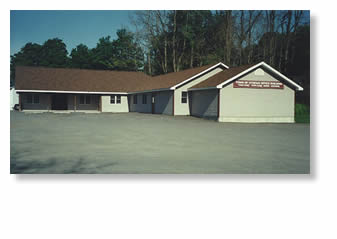 Focus
on
Focus
on
Fly Creek
In the center of the Town of Otsego...
Welcome to Historic Fly Creek!
Let’s get the first question on many visitors minds out of the
way: Why Fly Creek? We’re not plagued by those pesky little insects,
so why that name? The best answer derives from this area’s earliest
explorers. Dutch traders passed through our valley as early as 1714,
trekking south to Otsego Lake. The Dutch word for “marsh” is “vlie”,
and our hamlet’s creek rises in a marsh to its north. So it’s
likely that those Dutchmen named the creek Vlie Creek and, indirectly,
the later settlement of Fly Creek.
Fly Creek’s real history begins just after the Revolution, when thousands headed for new lives on the frontier which ran, back then, right through Central New York. Among the pioneers were some speculators who bought up thousands of acres surrounding Oaks and Fly Creeks.
The speculators saw profit in those fast-moving creeks. New settlers would need mills for grinding grain, sawing logs, carding wool, making machinery. By the early 19th century, eight mills flourished along Fly Creek and four on Oaks Creek. That commerce gave birth to our hamlet, with Oaks Creek flowing to its west and Fly Creek coursing through it. In short order, Fly Creek, and nearby Oaksville and Toddsville, became busy little villages.
By 1872 Fly Creek itself had 325 residents in 67 dwellings. Besides mills, it boasted a general store, a machine shop, three blacksmiths, a foundry, two wagonwrights, a cobbler, a creamery, two hat shops, and a hotel. On Sunday mornings, bells of three churches echoed through our lovely valley. Nearby Oaksville was home to two hundred residents and a three-story brick cotton mill, plus shops and stores.
Surrounding the hamlets, small farms divided the valley bottoms and climbed into the surrounding hills. Dairy farming dominated and until a 1910 blight, a major farm crop was hops, an essential ingredient in brewing.
Fly Creek today is almost unchanged in size. Victorian houses predominate in the hamlet, though a few dwellings predate the Constitution. One church remains, both spiritual and social heart to the community, and now on the National Register of Historic Sites. Besides a general store, a working cider mill, B&Bs, and interesting retail shops, the area’s craft tradition continues alive and well. Skilled local artisans work at pottery, cabinet making, leatherwork, sculpture, painting, photography, quilting, and antique restoration and sales.
In 1999 the Fly Creek Historical Society was fortunate to be able to acquire the Pamona Grange building to be used as headquarters for the Historical Society, museum to display their artifacts and a gathering place for community events. Restoration and renovation will be ongoing for the foreseeable future and we appreciate any donations of money, labor or artifacts.
Take your time in exploring the Fly Creek area. We feel very happy and very lucky to be living here and we’re glad to share it with you today.
October 29, 2005